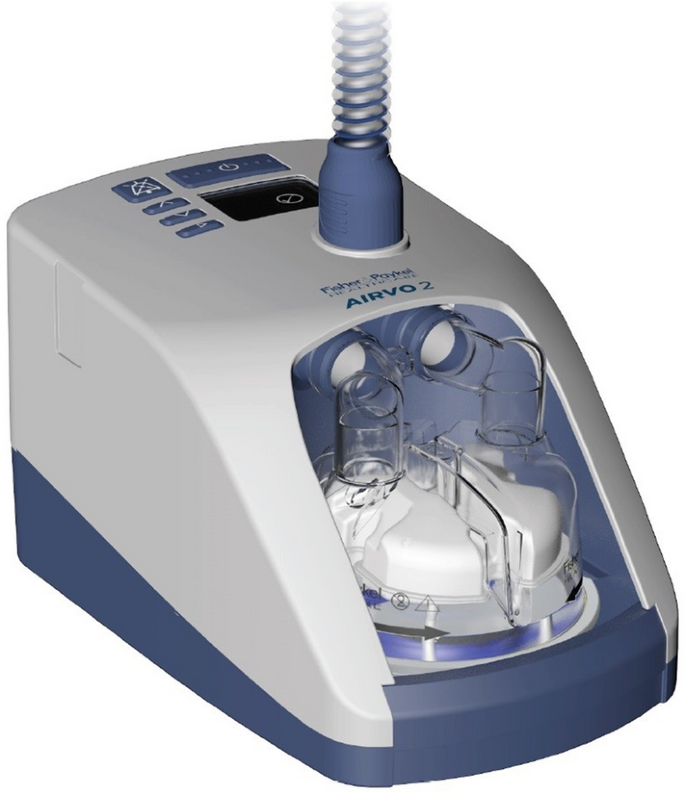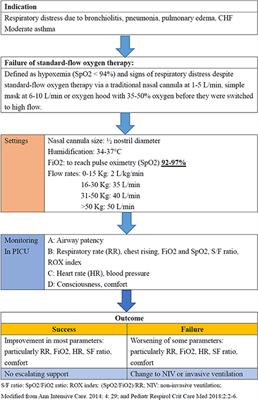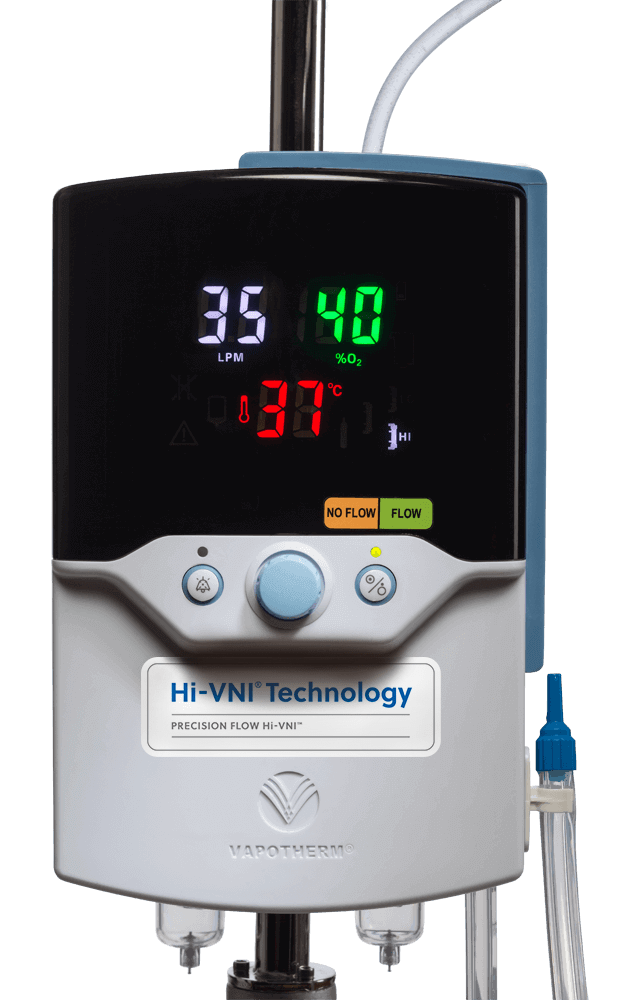heated high flow oxygen levels
High-flow nasal cannula HFNC is a heated and humidified system that allows prescribed fraction of inspired oxygen F I O 2 levels to be delivered at very high flow rates. However a target SpO 2 of 92 to 96 seems logical considering that indirect evidence from patients without COVID-19 suggests that an SpO 2 of 96 may be harmful.
Heated humidified oxygen is administered through a high- flow nasal cannula when a patient requires a higher dose of supplemental oxygen or increased flow for shortness of breath.

. In recent years nasal cannulae designed to administer heated and humidified airoxygen mixtures at high flows up to 60 Lmin have been gaining popularity. Traditionally nasal oxygen therapy has been delivered at low flows through nasal cannulae. All settings are controlled independently allowing for greater confidence in the delivery of supplemental oxygen as well as better outcomes when used.
Traditional oxygen delivery systems do not exceed 16 Lmin while HFOT can deliver up to 60 Lmin and as high as 100 oxygen Lindenauer et al 2014. These high-flow nasal cannula HFNC systems enhance patient comfort and tolerance compared with traditional high-flow. These high-flow nasal cannula HFNC systems enhance patient comfort and tolerance compared with traditional high-flow.
This includes a high-flow nasal cannula a high-flow source with systems regulating the flow and the FiO 2 a humidifier system and heated tubing. High-flow Nasal cannula consists of a specific machine and tubing used to deliver a very high flow of oxygen that is heated and humidified. This high flow can provide more constant inspiratory oxygen concentrations than conventional oxygen therapy and can also generate some positive end expiratory pressure.
In contrast high flow nasal cannula HFNC is a system used in the hospital that delivers up to 100 oxygen at flow high flow rates up to 60 liters per minute. Gotera Díaz Lobato Pinto Winck 2013. Suitability of High Flow Oxygen Devices for Acute Care.
The HR for death by day 28 was 049 in the high-flow oxygen group compared with the conventional oxygen group or a 51 risk reduction. High flow heated 34 C and humidified nasal oxygen is given with the OptiFlow System Fisher Paykel Aukland New Zealand using a flow of 50 literminute and an inspiratory oxygen fraction FiO. The utility of heated and humidified high-flow nasal oxygen HFNO for severe COVID-19-related hypoxaemic respiratory failure HRF particularly in settings with limited access to intensive care unit ICU resources remains unclear.
Median ventilator-free days by day 28 was 28 in the high-flow oxygen group versus 24 in the conventional oxygen group adjusted odds ratio 077. 5 This system provides high-flow 30 to 60 LPM oxygen that is heated to body temperature 37 o C and is fully saturated 100 relative humidity with minimal or no rainout in the tubing. High-flow therapy can effectively deliver higher flow rates to patients than Venturi-based systems with a greater level of comfort.
Hypercapnic patients showed a significant decrease in mean PaCO 2 levels after one hour of HHHFNO use 7033mmHg SD 1963 vs. High-flow oxygen therapy emulates the temperature and humidity of a healthy adult lung 37C and 44 mgL H 2O optimizing mucociliary clearance by preserving the function of the ciliated mucosa reducing the risk of respiratory tract infections. Goal of Oxygenation.
3238mmHg SD 370 P0919. The system heats up to normal body temperature 37 Centigrade and humidifies the oxygen which is more comfortable for the individual. If you are admitted to the hospital for a COPD flare-up.
In addition studies have shown that high flow oxygen therapy may help patients recover faster and avoid invasive. The optimal oxygen saturation SpO 2 in adults with COVID-19 who are receiving supplemental oxygen is unknown. Heated humidified high-flow HHHF therapy often also high flow nasal cannula e HFNC or high flow nasal oxygen HFNO is a type of respiratory support method that delivers a high flow liters per minute of medical gas to a patient through an interface nasal cannulae intended to create a wash-out of the upper.
High-flow oxygen was associated with lower risk of intubation at days 7 and 14. Fraction of inspired oxygen FiO2 of 21 to 98 relative humidity of 95 to 100 a flow rate of 15 to 60 Lminute. Lets now consider how HFNC can help our patients improve their respiratory disease.
HFOT can meet or exceed the patients demand minimizing the risk of air dilution and the inaccurate delivery of oxygen. The device can deliver. In recent years nasal cannulae designed to administer heated and humidified airoxygen mixtures at high flows up to 60 Lmin have been gaining popularity.
It is used for the application of heated and humidified blended air and oxygen at high flow rates typically set between 30 lmin and 50 lmin. High Flow systems available today can generate flow rates anywhere between 2-120 litresminute much like ventilators. MICU CVICU SNICU PICU BICU ED RSCCU.
HFNP may act as a bridge between low flow oxygen therapies and CPAP reducing the need for CPAPintubation. HI-Flow Star is a nasal oxygen delivery system for adult patients. HFNC can be delivered from 8-60Lmin 30-60 Lmin in adults and an FIO2 of 100.
FiO2 can be accurately set and monitored. Traditionally nasal oxygen therapy has been delivered at low flows through nasal cannulae. Heated humidified high flow nasal oxygen HFNO a technique that can deliver heated and humidified oxygen with a controlled fraction of inspired oxygen FiO 2 at a maximum flow rate of 60Lmin via a nasal cannula.
At high flows of 2 litres per kilogram per minute using appropriate nasal prongs a positive distending pressure may be achieved. An alternative to conventional oxygen therapy has received growing attention. High Flow systems are those that can match or exceed the inspiratory flow rate ie 20-30 litresminute.
Humidified high flow nasal prong HFNP therapy is a form of non-invasive respiratory support. Patients in our study were asked not to speak during anesthesia induction and keep the mouth closed. Heated High Flow Oxygen using OptiFlow system at UIHC UIHC currently utilizes Fisher Paykels OptiFlow system to deliver Heated High Flow Oxygen Therapy This system is approved for use in the following areas.
First High Flow Oxygen Therapy HFOT is an oxygen delivery system which provides heated humidity with high flow levels of oxygen O2. There are three main proposed benefits of HFNC. 5500mmHg SD 1328 P0041 with no change in PaCO 2 levels in patients who were not hypercapnic prior to HHHFNO use PaCO 2 3271mmHg SD 528 vs.
HFNC is more comfortable and studies have shown that using HFNC may be a better alternative than using a face mask. High-flow nasal cannula HFNC therapy is an oxygen supply system capable of delivering up to 100 humidified and heated oxygen at a flow rate of up to 60 liters per minute.

Clinical Efficacy Of High Flow Nasal Oxygen In Patients Undergoing Ercp Under Sedation Scientific Reports

How Does High Flow Nasal Cannula Hfnc Work Medmastery

Oxygen Delivery In The Home Setting
Clinical Guidelines Nursing Oxygen Delivery

Frontiers High Flow Nasal Cannula Therapy In Children With Acute Respiratory Distress With Hypoxia In A Pediatric Intensive Care Unit A Single Center Experience Pediatrics

How Does High Flow Nasal Cannula Hfnc Work Medmastery

Noninvasive Respiratory Support In Neonates A Review Of Current Evidence And Practices Springerlink

What Is A High Flow Nasal Cannula Hfnc Flow Oxygen Medical Equipment
Difference Between Low Flow And High Flow Oxygen Difference Between

Equipment Used For The Nasal High Flow Oxygen Therapy System We Used A Download Scientific Diagram
Clinical Guidelines Nursing Oxygen Delivery

How Does High Flow Nasal Cannula Hfnc Work Medmastery

Optiflow Nasal High Flow System Fisher Paikel Healthcare The Download Scientific Diagram

F Io 2 During Mouth Closed And Mouth Open Breathing Download Table

Optiflow Nasal High Flow System Fisher Paikel Healthcare The Download Scientific Diagram
The High Flow Nasal Cannula In The Emergency Department Emupdates

High Flow Noninvasive Ventilation And Awake Nonintubation Proning In Patients With Coronavirus Disease 2019 With Respiratory Failure Chest
